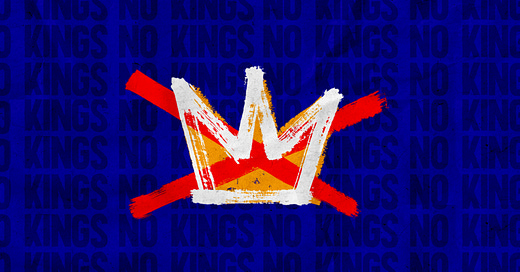Fresh from activating the National Guard and threatening to arrest a governor and mayor, Donald Trump is ready for his spectacular Flag Day parade, complete with “thundering tanks” and “breathtaking flyovers.” Over 150 vehicles and 6,000 soldiers are expected in the nation’s capital, even though city officials blocked a similar plan years ago out of concern that the tanks would tear up D.C.’s streets. The parade alone — not to mention fireworks and other pageantry timed to Trump’s 79th birthday — will cost taxpayers at least $40 million, with at least $16 million allocated to repave the roads.
Behind the Flag Day festivities sits the US Semiquincentennial Commission —America 250 — created by Congress to orchestrate the 250th anniversary of the signing of the Declaration of Independence. Its all-star cast includes Pam Bondi, Marco Rubio, and Pete “send in the Marines” Hegseth.
America 250’s Flag Day will celebrate the Army’s 250th birthday while “looking boldly toward the next 250 years of American patriotism and technological advancement.” That’s a lot of “250” for year 249.
The military parade is just one of many official Semiquincentennial activities. In the months ahead, keep your eyes peeled for America’s Field Trip, America’s Invitation, America Gives, America Innovates, and America Waves.
During the Declaration’s Bicentennial in 1976, President Gerald Ford issued a proclamation recognizing the importance of Flag Day. That year’s festivities proceeded more or less without a hitch. The Left had its moment — including the Boston Oil Party in 1973 and a series of protests in Philadelphia in 1975 — but the Ford administration’s narrative of patriotism and unity prevailed.
Fifty years ago, the People’s Bicentennial Commission — an offshoot of the New Left and antiwar movement that believed Marxists were too anti-American and sought to use American cultural and political symbols for progressive goals — emerged to protest the Bicentennial. The Commission emphasized the promises in the Declaration of Independence, arguing that its “message of equality and inalienable rights” was still relevant. Many of the Commission’s demands, including economic democracy and changes to the school curriculum to teach the “real history of the [American] people,” were presented in newspapers and its planning and activity guide.
Flash forward half a century. The most prominent opposition to Trump’s Flag Day comes from the 50501 movement and its No Kings rallies. The event website reads:
They’ve defied our courts, deported Americans, disappeared people off the streets, attacked our civil rights, and slashed our services. The corruption has gone too far. No thrones. No crowns. No kings.
But recognizing the problem isn’t the same as offering a solution. The trouble with 50501 is its explicit endorsement of the Constitution — ironic, considering it’s the Constitution that led to Trump in the first place and continues to grant him the monarchical powers many oppose.
It remains to be seen how Flag/King Day will play out. Will the flyovers be breathtaking? Will one of Hegseth’s tanks crash into the Lincoln Memorial? Will Trump enjoy a slice of cake? With all the military equipment rolling in — is this a coup?
If you’re attending a No Kings march on June 14, consider carrying a sign that points to the need for a democratic constitution. We must do our best to reframe the conversation around the need for a new democratic founding.




